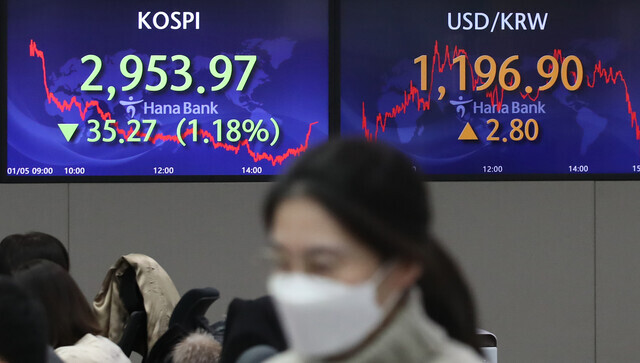hankyoreh
Links to other country sites 다른 나라 사이트 링크
Won’s value against dollar dips for 4th straight day

The South Korean won has been depreciating for four days in a row, placing 1,200 won to the dollar in the crosshairs. The drop is apparently impacted by a worsening trade balance and concerns about shrinking dollar liquidity.
The won-dollar exchange rate in the Seoul foreign exchange market rose 2.8 won Wednesday as the won declined in value, closing the day at 1,196.9 won. That’s the highest the rate has been since Oct. 12, 2021 (1,198.8 won).
The exchange rate nearly touched 1,200 won Wednesday, rising as high as 1,199.7 during trading. The last time the exchange rate was above 1,200 won was on July 24, 2020, when it hit 1,201.5.
The South Korean won’s drop in value can be attributed to the strengthening of the US dollar. Following observations that the Federal Reserve will hasten steps towards fiscal austerity, the US Treasury yield rose, which in turn bolstered the dollar. The US 10-year Treasury yield finished at 1.647% Tuesday, the highest it’s been since Nov. 23 of last year (1.665%). The Fed is expected to taper its bond purchases until the end of the first quarter, which means there won’t be additional dollar liquidity supplies.
Another factor that contributed to the weakening of the South Korean won is the forecast that the interest rate gap between South Korea and the US will narrow. Market projections indicate that the Fed will hike its current interest rate of 0% to 0.25% a total of three times this year. On the other hand, the Bank of Korea is projected to raise its current interest rate (1.00%) up to two times this year.
However, there is more to the recent decline of the South Korean won than the US’ belt-tightening and the strengthening of the dollar. The won began to falter around the middle of December, with Wednesday’s won value 1.36% below that recorded on Dec. 17. During the same period, the dollar declined in value by 0.28% as well instead of increasing.
Experts say that the won’s recent losses can be explained by South Korea’s flattening export growth and trade deficit. Last month, due to the simultaneous rise of raw materials and energy costs, South Korea’s trade balance hit a deficit of US$586 million after 20 months of surpluses.
Daily trade growth averaged at 15.9%, a steep drop from the 26.5% of the month prior. Trade indexes, such as trade surplus amounts, influence shifts in the won’s exchange rate via the flow of foreign currencies.
According to data from Yuanta Securities Korea, last year’s trade surplus (US$29.5 billion) only amounted to 40% that of the average yearly trade surplus from 2015 to 2019 (US$76.6 billion) before the COVID-19 pandemic, as imports (31.5%) grew more than exports (25.8%) in 2020.
Jeong Won-il, a researcher at Yuanta Securities Korea, said, “Because trade terms are not ideal considering export and import prices, the won will continue its weak streak for a while.”
By Han Gwang-deok, finance correspondent
Please direct questions or comments to [english@hani.co.kr]
Editorial・opinion
![[Correspondent’s column] The real reason the US is worried about Chinese ‘overcapacity’ [Correspondent’s column] The real reason the US is worried about Chinese ‘overcapacity’](https://flexible.img.hani.co.kr/flexible/normal/500/300/imgdb/original/2024/0510/5217153290112576.jpg) [Correspondent’s column] The real reason the US is worried about Chinese ‘overcapacity’
[Correspondent’s column] The real reason the US is worried about Chinese ‘overcapacity’![[Editorial] Yoon’s gesture at communication only highlights his reluctance to change [Editorial] Yoon’s gesture at communication only highlights his reluctance to change](https://flexible.img.hani.co.kr/flexible/normal/500/300/imgdb/original/2024/0510/7717153284590168.jpg) [Editorial] Yoon’s gesture at communication only highlights his reluctance to change
[Editorial] Yoon’s gesture at communication only highlights his reluctance to change- [Editorial] Perilous stakes of Trump’s rhetoric around US troop pullout from Korea
- [Guest essay] Preventing Korean Peninsula from becoming front line of new cold war
- [Column] The state is back — but is it in business?
- [Column] Life on our Trisolaris
- [Editorial] Penalties for airing allegations against Korea’s first lady endanger free press
- [Editorial] Yoon must halt procurement of SM-3 interceptor missiles
- [Guest essay] Maybe Korea’s rapid population decline is an opportunity, not a crisis
- [Column] Can Yoon steer diplomacy with Russia, China back on track?
Most viewed articles
- 1Korea likely to shave off 1 trillion won from Indonesia’s KF-21 contribution price tag
- 2Nuclear South Korea? The hidden implication of hints at US troop withdrawal
- 3[Editorial] Perilous stakes of Trump’s rhetoric around US troop pullout from Korea
- 4With Naver’s inside director at Line gone, buyout negotiations appear to be well underway
- 5In Yoon’s Korea, a government ‘of, by and for prosecutors,’ says civic group
- 6[Column] ‘Choson’: Is it time we start referring to N. Korea in its own terms?
- 7‘Free Palestine!’: Anti-war protest wave comes to Korean campuses
- 8How many more children like Hind Rajab must die by Israel’s hand?
- 9Overseeing ‘super-large’ rocket drill, Kim Jong-un calls for bolstered war deterrence
- 10[Photo] ‘End the genocide in Gaza’: Students in Korea join global anti-war protest wave